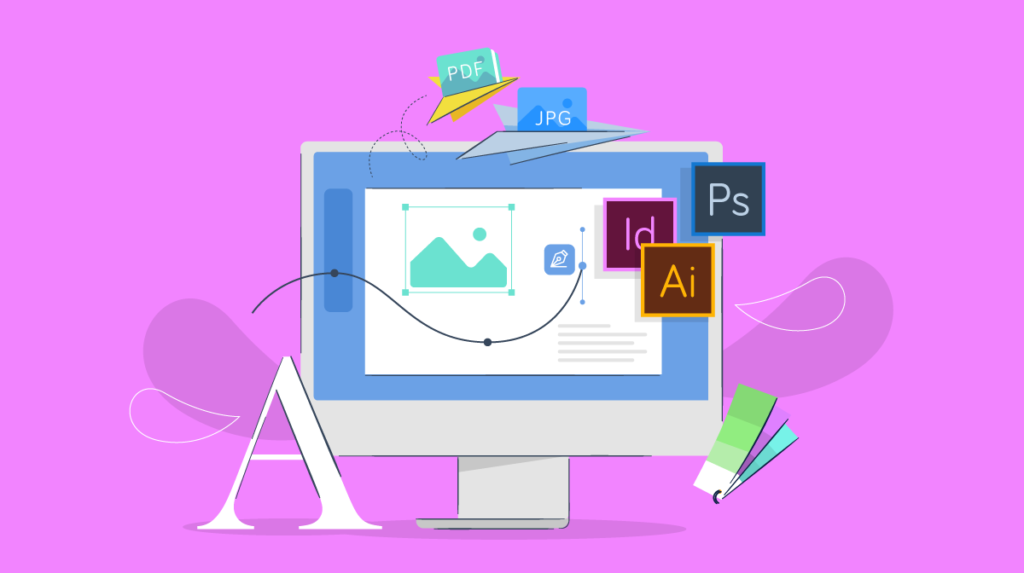What is Graphic Design?
 1. Definition:
Graphic design is a creative process that involves combining visual elements, typography, and imagery to convey a message or communicate information.
2. Key Elements:
1. Definition:
Graphic design is a creative process that involves combining visual elements, typography, and imagery to convey a message or communicate information.
2. Key Elements:
- Visual Elements: Incorporating images, illustrations, and symbols.
- Typography: Using fonts and text to enhance visual communication.
- Layout: Organizing elements on a page or screen for effective composition.
- Color Theory: Understanding and applying color principles for aesthetic appeal.
- Communication: Facilitates effective communication through visual means.
- Brand Identity: Helps in building and maintaining a consistent brand image.
- Engagement: Attracts and engages the audience through compelling visuals.
Courses:
- Graphic Design Certificate: Provides a comprehensive understanding of graphic design principles.
- Best Graphic Design Course: From IIHT Surat, Explore the top-rated course modules for in-depth learning.
- Graphic Design Courses with Certificates: Programs that offer certification upon completion.
- Learn Graphic Design: Beginner-friendly courses for those new to graphic design.
- Best Graphic Design Software: Tools like Adobe Photoshop, Adobe Illustrator, After Effects, CorelDraw, and Camtasia for professional graphic design work.
Graphic Design Courses in Surat:
- Explore local options for pursuing graphic design education in Surat.
Why It Is Essential To Choose The Right Graphic Design Course?
|
Criteria |
Importance |
Explanation |
|
Graphic Design Certification |
High |
A Credibility to your skills and increases employability. Employers often look for certified individuals, making it essential to choose a course that provides a recognized and respected certificate. |
|
Quality of Graphic Design Courses |
High |
Choosing a course that offers a creative approach towards teaching Graphic designs, tips, and hacks that are industry competitive should be the top pickers. |
|
Learning Experience |
High |
A good course should provide an engaging and practical learning experience. Look for courses with hands-on projects, real-world applications, and interactive elements to enhance your understanding and application of graphic design concepts. |
|
Reputation of the Course Provider |
High |
Opting for courses offered by reputable institution ensures that you receive a quality education. Check reviews, testimonials, and the track record of the course provider to gauge the effectiveness and reliability of their graphic design courses. |
|
Graphic Design Software Coverage |
High |
Ensure that the courses cover a variety of graphic design software widely used in the industry, such as Adobe Creative Suite (Photoshop, Illustrator, After Effects, and CorelDraw). Proficiency in popular tools is crucial for a successful career in graphic design. |
|
Flexibility of Learning Schedule |
Moderate |
Consider your availability and preferred learning pace. Choose courses that offer flexibility in terms of scheduling, allowing you to balance learning with other commitments. This is particularly important for individuals with busy schedules or part-time learners. |
|
Industry-Relevant Curriculum |
High |
Look for courses that align with current industry trends and standards. Graphic design evolves, and staying updated with the latest techniques and technologies is crucial. A curriculum that addresses industry demands enhances your employability. |
|
Inclusion of Practical Projects |
High |
Practical application of knowledge is key in graphic design. Courses incorporating real-world projects, case studies, and portfolio-building assignments provide valuable hands-on experience, making you more adept at tackling actual design challenges. |
|
Networking Opportunities |
Moderate to High |
Courses that facilitate networking with professionals and peers can be advantageous. Networking opens doors to job opportunities, collaboration, and mentorship. Consider courses that provide forums, events, or communities for connecting with others in the field. |
|
Availability of Support Resources |
Moderate to High |
We offer Access to support resources with, Q&A sessions, to enhance the learning experience. Our course provides adequate support structures to help you overcome challenges, and clarify doubts, with guidance from experienced professionals. |
|
Local Relevance |
IIHT Surat is the best platform to pursue your Graphic design dream. We offer a 90-day course on Graphic Design which includes concepts like Design basics, Illustrator, Photoshop, Corel Draw, and Camtasia. |
What are the important factors to consider while choosing a graphic design course?
Choosing the right graphic design course involves considering various factors. Let's break down the key factors in a combination of tabular format, bullet points, and discussion:|
Factor |
Considerations |
Discussion |
|
Accreditation and Certification |
- Check if the course offers a recognized graphic design certificate. |
Accreditation ensures the course meets industry standards. A certificate adds credibility to your skill set. |
|
Curriculum and Content |
- Review the syllabus for comprehensive coverage of design principles, software, and practical projects. |
A well-rounded curriculum ensures you gain both theoretical knowledge and hands-on experience with design tools. |
|
Instructor Quality |
- Look for courses taught by experienced professionals or industry experts. |
High-quality instructors can provide valuable insights and real-world perspectives, enhancing your learning. |
|
Mode of Delivery |
- Consider whether the course is offered online or in-person, and choose based on your preferred learning style. |
Online courses offer flexibility, while in-person courses may provide more direct interaction and feedback. |
|
Duration and Flexibility |
- Evaluate the course duration and flexibility to ensure it aligns with your schedule and learning pace. |
A balance between a reasonable duration and the flexibility to learn at your own pace is crucial for success. |
|
Practical Projects and Portfolio |
- Check if the course includes practical projects to build a strong portfolio. |
Real-world projects help apply theoretical knowledge and create a portfolio essential for showcasing your skills. |
|
Software and Tools |
- Ensure the course covers the best graphic design software like Adobe Creative Suite or other industry standards. |
Proficiency in widely used tools is vital for a graphic designer's success, as employers often require these skills. |
|
Reviews |
- You should read reviews, and connect with alumni to have a holistic understanding of the course relevance for you. |
Feedback from others can provide insights into the course's strengths, weaknesses, and overall satisfaction. |
|
Cost and Financial Aid |
- Compare the cost of the course with your budget and check for any available financial aid or scholarships. |
While cost is a factor, also consider the value and potential return on investment in terms of skills and career advancement. |
|
Industry Connections and Networking |
- Explore whether the course facilitates networking opportunities or has connections with the graphic design industry. |
Networking can open doors for internships and job opportunities, enhancing your career prospects. |
|
Local Relevance |
- If you are specifically looking for courses in a particular location, like Graphic Design Courses in Surat, ensure the course meets local industry needs. |
Local relevance can provide insights into regional design trends and job opportunities. |



